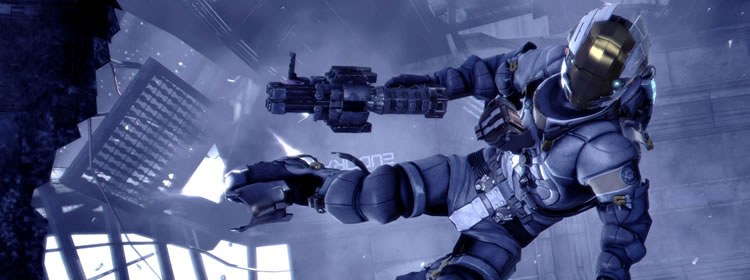The third installment in the Dead Space series was released this month, and considering the game made our list of 2013's most anticipated PC games we thought we would check it out to see how it looked and performed. Dead Space 3 is the direct sequel to the January 2011 release of Dead Space 2.
Like the first two games, Dead Space 3 77 is a survival horror third-person shooter. In addition to drop-in/drop-out co-op, Dead Space 3 introduces several new gameplay mechanics, such as the ability to roll for more responsive control and an organic, automatic cover system that doesn't require you to press a button to duck behind something.
Like its predecessor, Dead Space 3 has been developed in-house by Visceral Games using their own Visceral Engine. With this we anticipate to see just subtle improvements in terms of visual quality over Dead Space 2 which was a DirectX 9-only title.

The reason for this is simple, Dead Space 3 has been developed for consoles and then ported directly to PC. Although it is possible to turn some settings up a little higher on the PC, modern features that are part of DirectX 11 or high-resolution textures are not supported out of the box.
This is a real shame, but not at all surprising as this is how most cross-platform games end up on PC. Normally we'd skip console ports, as we did with Dead Space 2, however Dead Space 3 was already being heralded as "one of the best games of this generation" by Game Informer just days after its release and therefore we felt it was worth checking out.
The game seems to be receiving higher praises on PlayStation 3 and Xbox 360 when compared to PC, and as expected PC fans of franchise are not impressed with the lack of visual features. Visceral has been copping some heat, however executive producer Steve Papoutsis is a bit baffled as to why...
"It's confusing to me that this question even comes up, it's by no means any less important to us and it gets a lot of attention. The PC is a very different platform. As developers, you want to deliver an experience that's as similar as possible on different platforms. In Dead Space 2, I felt we made some great strides in terms of controls, responsiveness and even the visual improvements we got into it. We continue to evolve our games as we develop them, but we certainly don't target PC as something that's going to be significantly different. We aren't trying to create disparity in the experience that our gamers enjoy; we want to make sure everyone's having that same experience."
We believe Steve Papoutsis is missing the point. Dead Space 3 on PC is competing in a market where other developers at least go to some effort to play to the system's strengths and games such as Battlefield 3 and Crysis 3 are perfect examples of that. Keep in mind gamers are also paying top dollar for Dead Space 3, so the fact that it doesn't support DirectX 11 features as offered by most other AAA ports should not cause Visceral's Papoutsis any confusion.

Testing Methodology
Normally we test new games with over two dozen graphics cards and use multiple platforms to measure CPU performance. However this time, knowing in advance Dead Space 3 wasn't going to be overly demanding we decided to run a more concise test of 11 graphics cards on a single platform.
CPU performance didn't seem too relevant as any processor supporting 4 threads is providing playable performance. For virtually the same reason we are only testing a range of current generation GPUs covering all price brackets.
As always the latest drivers will be used for both AMD and Nvidia graphics cards, and every card will be paired with an Intel Core i7-3770K processor. We're using Fraps to measure frame rates during 90 seconds of gameplay footage from Dead Space 3's first chapter, Isaac's Apartment.
|
|
 |
 |
 |
 |
